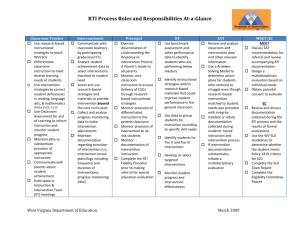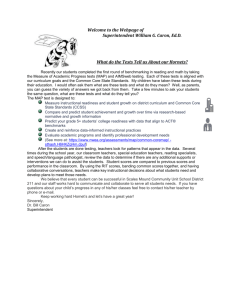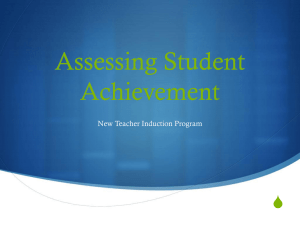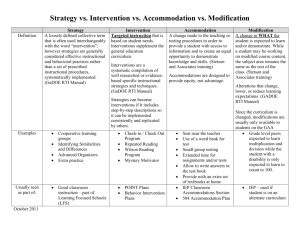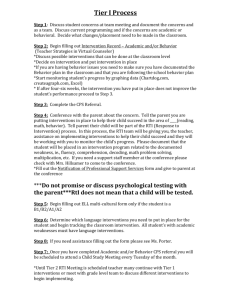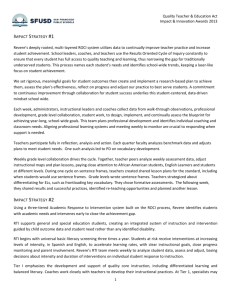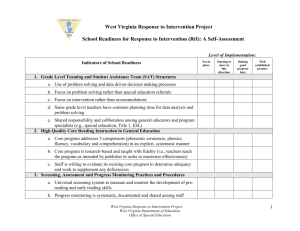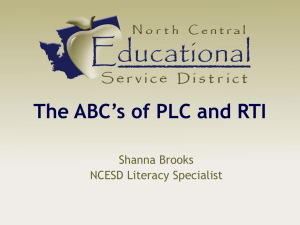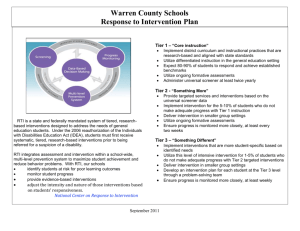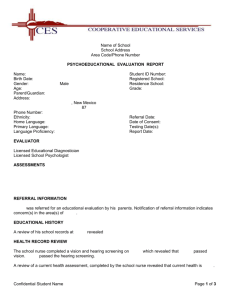here
advertisement
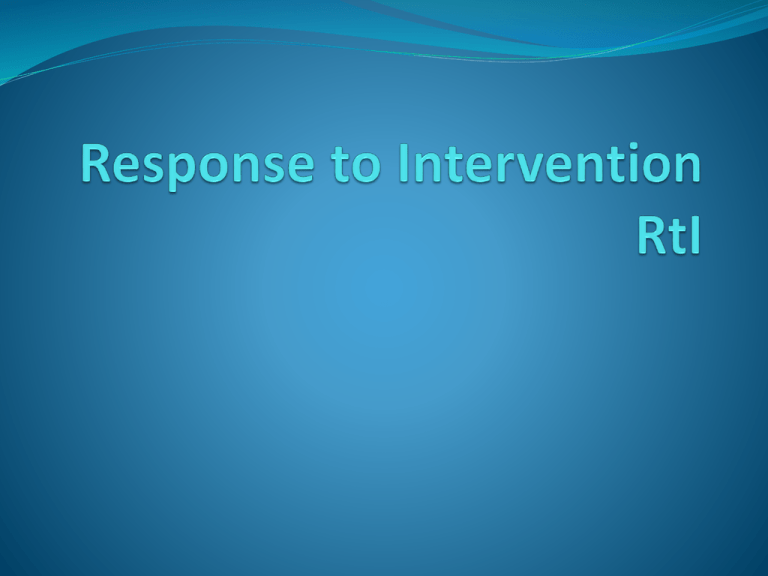
NYS Regulations define RtI as a school district's process to determine if a student responds to scientific, research-based instruction. 1. A school district's process to determine if a student responds to scientific, research-based instruction shall include the following minimum requirements: i. appropriate instruction delivered to all students in the general education class by qualified personnel; a. appropriate instruction in reading shall mean scientific research-based reading programs that include explicit and systematic instruction in phonemic awareness, phonics, vocabulary development, reading fluency (including oral reading skills) and reading comprehensive strategies; ii. screenings applied to all students in the class to identify those students who are not making academic progress at expected rates; iii. instruction matched to student need with increasingly intensive levels of targeted intervention and instruction for students who do not make satisfactory progress in their levels of performance and/or in their rate of learning to meet age or grade level standards; iv. repeated assessments of student achievement which should include curriculum measures to determine if interventions are resulting in student progress toward age or grade level standards; v. the application of information about the student's response to intervention to make educational decisions about changes in goals, instruction and/or services and the decision to make a referral for special education programs and/or services; and vi. written notification to the parents when the student requires an intervention beyond that provided to all students in the general education classroom that provides information about: a. the amount and nature of student performance data that will be collected and the general education services that will be provided pursuant to paragraph (2) of this subdivision; b. strategies for increasing the student's rate of learning; and c. the parents' right to request an evaluation for special education programs and/or services. 2. A school district shall select and define the specific structure and components of the response to intervention program, including, but not limited to, the criteria for determining the levels of intervention to be provided to students, the types of interventions, the amount and nature of student performance data to be collected and the manner and frequency for progress monitoring. 3. A school district shall take appropriate steps to ensure that staff have the knowledge and skills necessary to implement a response to intervention program and that such program is implemented consistent with paragraph (2) of this subdivision. • For more RtI information refer to the following website http://www.nysrti.org/ Examples of Interventions Tier – 1 : Academic Strategies: (Delivered by the classroom teacher in small, flexible groups) Build frequent opportunities for movements during instruction for kinesthetic learners Circulate among students and observe and question as they are working Make eye contact with students while giving directions and have them repeat directions ( e.g. turn to a partner, individually, chorally) Use clearly written directions and instructions in a step-by-step manner with illustrations and use as few words as possible Provide varied texts or supplementary materials at different levels of reading Use visuals, charts, and models for concepts reinforcement Use frequent monitoring to assess the progress and non-progress made by students so instruction can be adjusted in a timely manner Review and practice previously taught material frequently Utilize mnemonic cues (e.g. songs rhymes, stories, images) Examples Continued Tier – 2 : Academic Strategies: (core instruction plus supplemental instruction and assistance in small groups) Use multiple, flexible grouping opportunities for students (e.g. partners, independent, by interest, by learning style, teacher-assigned) Divide instruction into shortened segments and provide feedback to students before moving to the next segment Break assignments into smaller chunks to give students opportunities to respond frequently Increase opportunities for students to respond in a variety of ways (e.g. questions, dry-erase boards, thumbs-up, partner share, graphic organizers) Increase modeling, guided practice, and hands-on learning to increase student participation Use a laser pointer, stick pointer, highlighter tape, or colored pens to focus on key information in the text Provide access to a less distracting location for independent work Stop often to summarize key points Examples Continued Tier – 3: Academic Strategies: (intensive individualized interventions targeting skill deficits for longer time period than previously provided) Administer diagnostics that link directly to actual or suspended deficit in content area Meet daily to provide students with specific intense instruction targeted Consult with and involve instructional specialists and document actions taken Adjust and extend time as needed Use technological tools or computer software to allow student to access content in multiple ways Use multi-sensory techniques to present information Explain clearly each academic task and the specific criteria needed to successfully complete the task Review and practice previously taught material continuously Select a specific challenging behavior you would like to change. The behavior must be: •Observable •Measurable Challenging Behavior Concrete Definition Student is aggressive During lunch, when the student doesn't get his way, he hits other students Student is disruptive Student continuously calls out and makes inappropriate comments during mathematics classroom lessons Student is hyperactive Student continuously moves around in his seat and gets out of his seat without permission. He rarely completes assigned tasks and is constantly talking without permission. Once you have chosen a specific behavior to track the following information must be logged: Behavior: student Observable measurable disruptive action the commits. What does it look like? What does it sound like? Who is affected? Antecedent: committed? What was happening before the behavior was Setting: Where did the behavior take place? Consequence: student How did you react to the behavior? How did the react to the consequence? After identifying a behavior you wish change you then must find an efficient effective way to track the relevant information Narrative ABC Record Directions: Complete a narrative account of the situation using the boxes below. For each behavior observed, record what happened immediately before (Antecedents) and after (Consequences) each behavior. Note that sometimes a consequence leads directly to another behavior. Student: Setting: Date/Time: ANTECEDENTS BEHAVIORS CONSEQUENCES Scatter plot Dates: 8:00 8:15 8:30 8:45 9:00 9:15 9:30 9:45 10:00 10:15 10:30 10:45 11:00 11:15 11:30 11:45 12:00 12:15 12:30 12:45 1:00 1:15 1:30 1:45 2:00 2:15 2:30 2:45 3:00 3:15 3:30 ______ Monday _______ Tuesday _________ Wednesday _______ Thursday ______ Friday Comments . Week 1 9/17-9/22 Week 2 9/23-9/30 Week 3 10/1-10/7 Week 4 10/8-10/15 Week 5 10/16-10/23 Week 6 10/24-10/31 Great Leaps Scores 4, 5, 6, 4 Great Leaps Scores 5, 4, 6, 5, 4 Great Leaps Scores 5, 5, 6, 4, 4 Touch Math Scores 6, 7, 7, 8, 7 Touch Math Scores 9, 9, 7, 8, 7 Touch Math Scores 8, 9, 7, 8, 8 Remaining On-Task Rowena works hard but continues to struggle with math facts. She is typically ontask In-Class Work Completion Rowena always completes assigned work and while sometimes inaccurate, Rowena’s homework is always complete and accurate. She receives help from N/A Her efforts is apparent. Academic/ Behavior Problems Reading Decoding Reading Comprehension Math Computation Math Word Problems Homework Completion Non Compliance Refusals Disruptions, Interruptions, Talking Never Mom at home. Week 7 Academic/Behavior Problems Week 1 Inappropriate Comments/gestures Actions N/A Bullying/ Taunting Threats N/A Aggression towards Peers/Staff/Self N/A Attention Problem N/A Hyperactivity N/A Week 2 Week 3 Week 4 Week 5 Week 6 What growth should students have shown? What growth did similar students obtain? What is the difference between the expected growth and the actual growth? RtI Data/assessments will help teachers determine student baselines. This means staff will need to assess certain students more often and differently which will provide more data to determine student progress and growth. Other 60% (APPR) Begins with the teaching standards: 1. Knowledge of Students and Student Learning 2. Knowledge of Content and Instructional Planning 3. Instructional Practice 4. Learning Environment 5. Assessment for Student Learning 6. Professional Responsibilities and Collaboration 7. Professional Growth RtI/ Teacher Evaluation Domain 1/Planning and Preparation: Teacher uses knowledge of students’ varied approaches to learning in instructional planning. Teacher displays knowledge of students’ skills and knowledge for each student, including those with special needs. Goals take into account the varying learning needs of individual students or groups. Teacher is aware of resources available through the school and community and will use these resources to enhance instruction. Teacher uses assessment results/data to plan instruction for students. Domain 2/Classroom Environment: Teacher is knowledgeable of students’ Behavior Intervention Plans and consistently follows the plan and tracks behavior. The teacher shares this data visually with the student. Domain 3/Instruction: Teacher persists in seeking effective approaches for students who need help, using a variety of strategies and resources. Domain 4/ Professional Responsibilities: Teacher’s system for maintaining information on student completion of assignments and student progress in learning is highly effective. Teachers provides information to parents frequently about instruction and positive and negative aspects of student progress. Teachers are proactive in serving students and make conscious efforts to challenge negative attitudes to ensure all students receive a fair opportunity to succeed.
